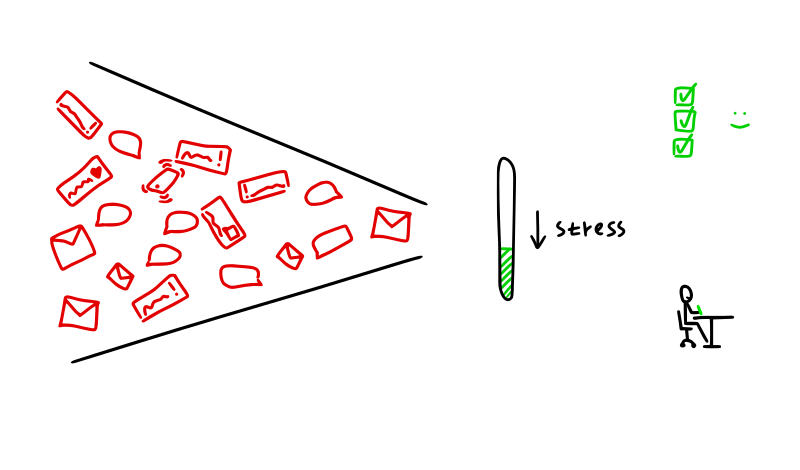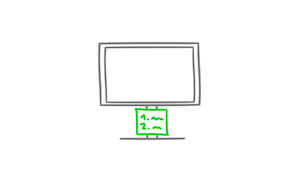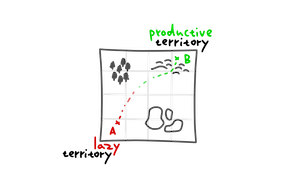How to increase your attention span: 5 key strategies
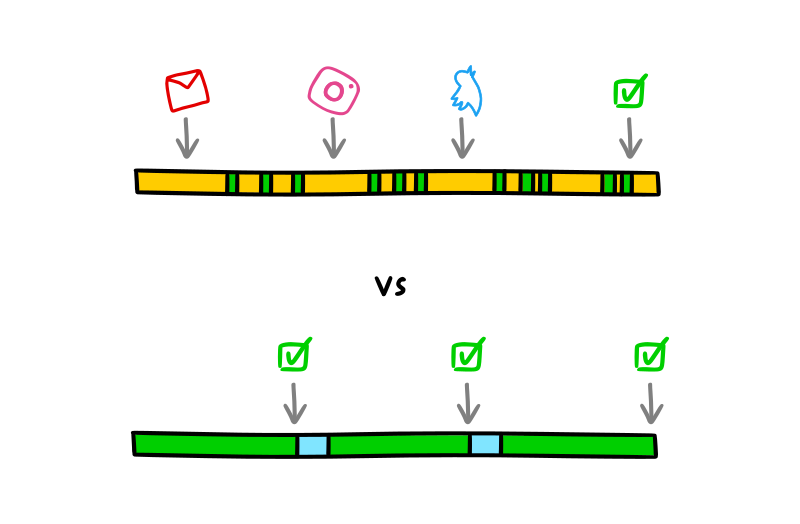
The average attention span length is 8 seconds. Have you heard that claim?
Well, we don't think it's quite as bleak. After all, a lot of us pay attention to a good book, Netflix series, or a game for hours and hours. Still, doing mostly passive things is different from focusing on work or studying.
How do we train ourselves to pay attention to difficult tasks for longer, immerse ourselves in work and feel engaged?
We'll get to that in a moment, but first we'll drive home why this matters.
Why increase attention span
Take any project you have. Could be a thesis, work project, or the fantasy novel you always wanted to write.
You can imagine the process of working on it as a progress bar.

Your attention span determines how much progress you can make on any given day.
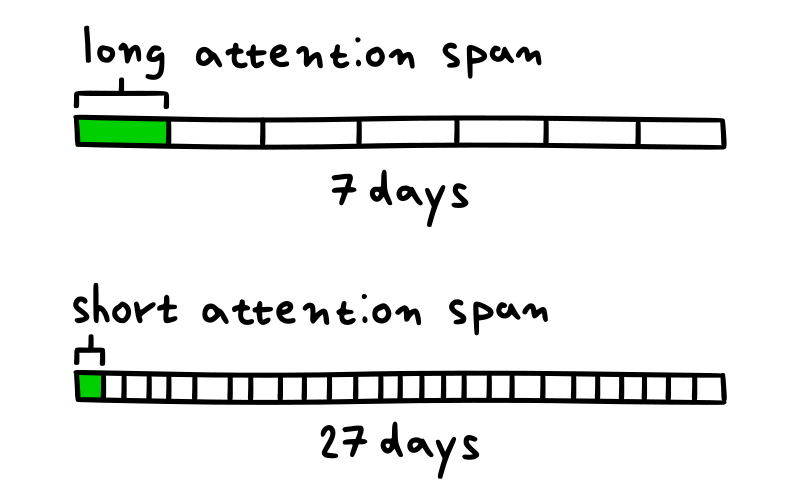
And that's the simple case for why being able to focus for longer matters.
Of course, there are real-world delays, unexpected interruptions, problems, and cancellations, but having a long attention span means that you'll do your work in a shorter amount of time. You'll also do it better. Why?
Your work requires some context. When you're in the thick of things, the context is loaded in your working memory. However, every day that you're not working on the project, that context is fading.
When the context fades altogether, it can take 10 minutes, 30 minutes, or even several hours to load it back into your mind to understand what to do next, and there's a high chance that you'll forget something vital. This loading process is a big reason why a lot of people "don't know where to start" - they don't have the relevant information loaded into their mind.
When you have a short attention span, you'll need more sessions to complete a project. More sessions means more loading, and also forgetting potentially useful ideas, making the work worse. On the other hand, when you lengthen your attention span, you'll need to load the project far fewer times. Less time spent loading, more time spent making progress.
So whatever you're procrastinating or even working on, with a longer attention span, you'll get it over with sooner and better.
With that, let's get to how to actually lengthen your attention span.
Before we begin: remember it's a process
Remember that increasing your attention span is not an overnight thing. Also remember that few strategies, tips, or tricks will help you if you do them only once. The more often you apply the tips below it, the more impact they'll have.
However, there are some one-time changes that can have lasting impact, so we'll take a look at those first. They usually have to do with setting up your work environment right.
1. Minimize cues for switching
Let's start with the obvious: interruptions.
Every interruption—notification, message, alert—represents a potential choice:
A: Ignore the interruption and keep working.
B: Endorse the interruption and switch tasks.
Each interruption is a cue for a potential task-switch. We want to limit the task switching as much as possible, so naturally we want to set up our work environment to prevent these cues from ever reaching our senses.
We've covered this before, so here are the main guides to check out:
- How to stop checking your phone
This guide helps you use your phone well. - The best ways how to reduce your internet use
This guide helps you set up your computer well.
Here's the short version of it: When you have distracting sites blocked on your computer and your phone out of sight and reach, in Do Not Disturb mode, there are far fewer interruptions, visual or auditory.
You don't want to see or hear notifications (unless they are absolutely urgent).
Those are external interruptions, there are also internal interruptions.
What to do with internal interruptions (What will I have for lunch? Did someone message me?...)? Write them down. Post-it notes or paper cards are great for this. When a thought occurs to you that's not related to the task at hand, write it down. Then deal with it after you're done working.
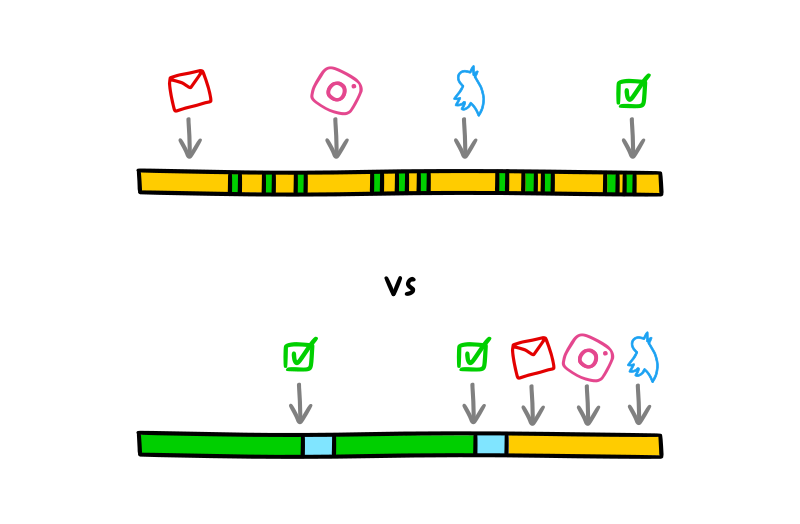
Realistically, 99% of ideas can wait until the session is over. Writing them down helps you free up your memory and get back to fully focusing on the task at hand.
- Change your environment to receive only the most urgent of external interruptions.
- Write down internal interruptions for later.
That's how you reduce or handle cues for switching.
Less switching → longer time on task → longer attention span.
2. Make switching tasks harder
Making it harder to switch tasks is also a good idea. That's a case where adding friction is good. Let's take a look at some examples.
When you go to work in a café, will you look at TikToks on your phone? Probably not. When we're observed by others, we change our behavior. Few of us want others to see us slacking, see us mindlessly browsing, or watching random videos. This adds an element of social cost to undesirable behaviors. Same could be set for being in meeting. If you're in a meeting, unwarranted task-switching carries consequences.
Another approach to staying on task longer is to make it so that it requires serious effort to switch. A clear cut example would be going for a bike ride. When you're miles away from home, often the simplest (and sometimes the only) way to return is to keep pedaling. Yes, perhaps you can use public transport, but then you'd be stuck in a bus somewhere, all sweaty and with a dirty bike. It's just simpler to continue riding.
The everyday work example could be something like putting your phone in a car, or unplugging your router and putting it on a high shelf.
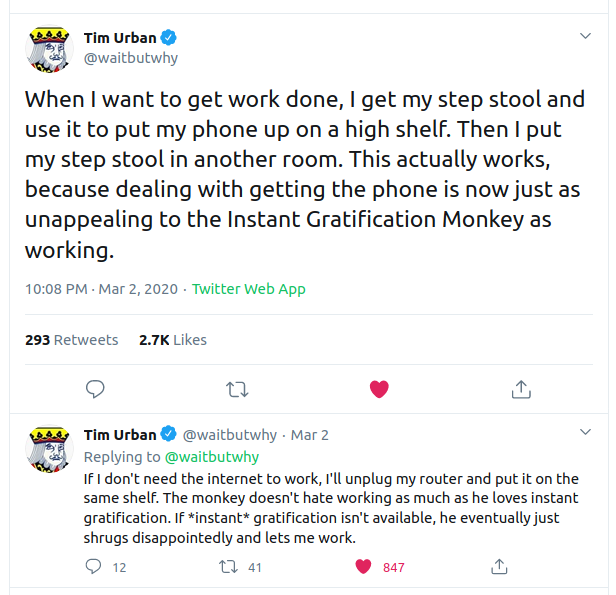
The harder you make it to switch, the more motivated you'll be to stay on task until it's over.
How can you make it harder to switch?
3. Single-task
This is common sense, but not common practice.
Multi-tasking is a myth. In reality, our attention is rapidly switching from one task to another. And, crucially, there is a cost with every such switch.
The process of neural network switching is associated with a decrease in accuracy, often for both tasks, and a time delay compared to doing one task at a time. Known as multitasking or task-switching costs, these decrements in performance occur for both types of goal management. You can think of these costs as the price you pay for trying to do more than one thing at a time.
—Adam Gazzaley, The Distracted Mind
Even if we know that rapid task-switching is detrimental to our mental performance, it can still be tempting. Why?
The Lure of Multi-tasking
There is some evidence that multitasking makes us feel more engaged.
A common explanation that is offered in response to this question is that it is simply more fun and rewarding to engage in multitasking compared to single tasking. There certainly appears to be truth in this assertion. Individuals report that enjoyment is a factor in Internet-based multitasking and that performing additional tasks while watching TV ads increases overall task enjoyment. Also in support of this view, physiological signs of increased arousal are associated with switches between multiple types of content on a single device.
—Adam Gazzaley, The Distracted Mind
This can be useful. If you need to do a boring task, then doing something else at the same time can help you actually get the task done. You increase the difficulty level to feel engaged. Example: you don't like filling out work reports, but when you put on a podcast it becomes bearable.
However, this becomes a problem when we try to combine tasks that interfere with one another. Example: listening to a podcast and writing. Both of these tasks use the same parts of our brain related to understanding language. If we try doing both, our mental faculties will be stretched thin and we won't get much from the podcast and our work will be half-hearted. Another example could be looking at your phone during a conversation with someone else. Because your attention is split, switching from your device to the conversation, the quality of the conversation will suffer.
Another reason why multitasking is luring is that many of us want to get done a lot of different things. We have long to-do lists.
It's tempting to try to work on as many tasks as possible. Do a bit of work here, a bit of work there,... It makes us feel busy, but busy doesn't mean productive.
This is your reminder that we do our best when we single-task. That's what our brain is wired for.
In short, even though task-switching can make us feel engaged and busy, when we do it our task performance suffers, and we're reinforcing the mental pattern of task-switching, not focusing.
Instead, train yourself to do a single task at a time. Purposefully do 1 thing at a time, for as long as you can. You can time yourself. Can you do 15 minutes? 30? 1 hour? Try it. Test yourself.
You can choose a work-related task to practice single-tasking, or something else: running, knitting, tidying,... So long as you're doing 1 thing for an extended period of time, you're training yourself to focus (and you also do the task better because your mind is not switching to other things.)
Pick at least 1 activity to practice single-tasking on.
4. Practice redirecting attention
In the Distracted Mind, neuroscientist Adam Gazzaley distinguishes between interruptions and distractions.
Interruption:
visual/auditory cue (external) or an irrelevant idea (internal)
Distraction:
interruption that you act on
This is an interesting distinction because it highlights that we can choose not to act on an interruption. Of course, many of us do it automatically.
PING! Check the phone.
What if I bought a lamp? Google "design lamps". ...
And this is where mindfulness (in any form) can come in handy in 2 ways.
- Mindfulness can prevent you from endorsing an interruption. You notice it, you pause, you stay on task, trusting that it's not an absolute emergency.
- Even if you do endorse the interruption and start getting distracted, mindfulness helps you catch yourself sooner, rather than later.
Of course, you can do this without any mindfulness or meditation practice. It's a habit any of us can develop. Notice you're getting side-tracked → redirect attention back to work.
However, mindfulness or meditation are an awesome training for this, because they train us to monitor our thoughts and catch ourselves when our mind wanders. Meditation can be viewed as a training of directing and redirecting your attention.
Your mind will likely wander, so if you know how to shift your attention consciously, you'll make it much more likely that you'll stay with the task at hand → longer attention span.
If you don't know where to start, Oak, Headspace, or Waking Up are good apps to check out.
5. Work in sessions
The idea of grinding 24 or 18/7 is also detrimental to our attention span. We're not wired to sustain the same levels of focus for 18 hours a day.
Our levels of alertness rise and fall throughout the day.
Now, if you're near a deadline and under pressure, maybe you can "power through" because of heightened cortisol levels and caffeine. Same applies for when you're super-excited about something. However, most days, it makes more sense to lean into the natural rhythms.
When you feel alert, dive into work. This is fairly obvious.
When you feel your energy waning, take a break. Some studies suggest that 20 minutes may be the ideal break duration. If you want some ideas for what constitutes a good break vs a bad break, check out this article.
Typically, 60-90 minutes is a really good mark to aim for. If 90 minutes is too long for you, you can also take shorter 5 minute breaks during the interval. The Pomodoro technique is an example of this.
25 min work + 5 min break * 3 = 90 minutes
45 min work + 5 min break + 45 min work = 95 minutes
Experiment with these options. In general, the shorter Pomodoro rhythm works better for repetitive work, while the longer 45 min * 2 or the full 90 min intervals work better for complex creative work.
In either case, expect that it should get uncomfortable towards the end of the session. If it's not, you're probably not stretching your attention span.
How long should you be able to focus?
This question is also worth addressing. The short answer is that it's highly individual. Some people can pay attention longer than others. Whether it's due to nature, nurture, or both, is debatable.
Regardless of your attention span length now, you can probably stretch it. You can improve your standard.
A more methodical way to approach this question is to conduct an experiment: track how much time you spend focusing deliberately.
Install a time-tracking app and track time spent in a particular app using tools like Screen Time on MacOS. Alternatively, buy an analog stopwatch or an hourglass even, and use them to measure your work sessions.
The 1st key step is to understand your current standard.
In order to improve something, we need to first understand where we are at the moment. For example, you might find out that you can study for 4 x 45 minutes each day, and then you feel drained. Ok, that's your current standard.
The 2nd step is to push yourself further.
Once you know what your current standard is, then you can try to go further. E. g. try to do 5 x 45 min sessions.
Not only does tracking key activities make the whole process more fun, it also makes you focus on your own progress.
It's easy to compare ourselves against others, and that can make us feel bad about ourselves, leading to more procrastination. But if we focus on our own process, we can feel good about making the trendline go up.
One thing to note is that, this kind of tracking can become tedious if we try to measure too many activities, so it's useful to start with just 1-2 activities that require focused effort or "deep work" and track those.
So how long should you be able to focus?
It depends, but you can almost certainly improve.
If you want to turn improving attention span length into a game, track your time spent on focused work. Stats make things fun.
Summary
How to increase attention span:
-
Minimize distraction cues
External cues: reduce notifications & messages, remove your phone from sight. Internal cues: write down distracting thoughts instead of acting on them immediately. -
Makes switching harder
Go to an environment where others can see if you're working or not. Put your phone in the car. Block distracting sites in the browser. -
Single-task as much as possible
Every day, try to pick at least one activity to focus on for an extended period of time, without switching. Can be: reading, journalling, or any work task. -
Redirect when you get side-tracked (you will)
When you get side-tracked during a work session, practice redirecting your attention back to the task at hand. Close the tabs, close the apps, and return to your work. For bonus points, start practicing redirecting through meditation of any kind. -
Work in sessions
We're not robots, we can't work 24/7. When you're alert, focus for as long as you can. Use shorter time intervals like Pomodoro for repetitive work, and longer intervals (2 x 45 min or 60-90 min) for creative work. When you get tired or can't focus, take a 20 min effective break.
If you do the above consistently, you'll already be ahead of most people.
Our attention span is a vital asset. It allows us to dive deep and make a lot of progress in a short amount of time.
Start increasing your attention span today.

